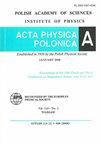Theoretical Model of a New Type Tunneling Transistor
IF 0.5
4区 物理与天体物理
Q4 PHYSICS, MULTIDISCIPLINARY
引用次数: 0
Abstract
A tunneling transistor without heterojunction as a theoretical design, or more precisely controlled electron current transmission by barrier potential, is under consideration. The electrons from the conduction band of the source tunnel through the forbidden gap $E_g$ of the channel to the conduction band of the drain. The tunneling current $J$ calculations made at helium temperature for the example InAs-InAs-InAs, Au-GaSe-Au and Al-AlN-Al structures show that for a constant source-drain voltage, $V_C$, of several mV, changes in the gate voltage, $V_G$, applied to the channel within the voltage range of 0 - $E_g/$2e change $J$ by even 10 orders of magnitude. Unlike the existing solutions such as tunnel field-effect-transistor (TFET), the proposed device uses the change of $V_G$ (gate voltage), i.e. the change of the electrostatic potential in the channel, to modify the imaginary wave vector $k_z$ of tunnel current electrons. Consequently, the gate voltage controls the damping force of the electrons wave functions and thus the magnitude of the tunneling current, $J$. The effect of increasing temperature, T, on $J(V_G)$ relation was also tested. It was found that only in structures with a wide forbidden channel gap this effect is insignificant (at least up to T=300 K).一种新型隧道晶体管的理论模型
本文章由计算机程序翻译,如有差异,请以英文原文为准。
求助全文
约1分钟内获得全文
求助全文
来源期刊

Acta Physica Polonica A
物理-物理:综合
CiteScore
1.50
自引率
0.00%
发文量
141
审稿时长
6 months
期刊介绍:
Contributions which report original research results
and reviews in the fields of General Physics, Atomic and
Molecular Physics, Optics and Quantum Optics, Quantum Information, Biophysics, Condensed Matter, and
Applied Physics are welcomed.
 求助内容:
求助内容: 应助结果提醒方式:
应助结果提醒方式:


